Bio 367 - behavior & communication, development & life histories
1/86
There's no tags or description
Looks like no tags are added yet.
Name | Mastery | Learn | Test | Matching | Spaced |
|---|
No study sessions yet.
87 Terms
communication
When an action or condition of one organism alters the behavior of another in an adaptive way
Why do insects communicate?
It may be an intraspecific prerequisite for behavior involving participation or cooperation
Adaptive values of communication
recognition of kin, locating members of opposite sex, give directions for food, regulate spacial distribution, antagonistic behavior, deception/mimicry
intraspecific comm.
within species
example of intrasexual comm.
When males are fighting in a lek to attract females
example of intersexual comm.
When males and females are interacting during courtship or parental care
example of interspecific comm.
When a stink bug releases odor or a plant releases a chemical that deters pests
example of food signaling
Honeybees do the waggle dance to signal food
example of food scarcity communication
When a plant is heavily infested and low on nutrients, aphids will pick up on signals to produce a generation of winged aphids for dispursal
example of alarm signaling
Hissing cockroaches will release an alarm pheromone that signals aggression and prompts bugs to quickly hide
example of trail cues
Ants will lay down trail pheromones that other ants can follow to a food source
example of growth and sexual maturation inhibition
Some colonial insects have queens that will produce pheromones that keep females from reaching sexual maturity
example of aggregation communication
When pine beetles find a new tree to feed on they produce an aggregation pheromone that can be sensed by others from a long distance
4 forms of communication
Visual, sound, light, chemical
modified spiracles
Forcing air through spiracles can create a hissing sou
wing vibration
Air can be forced through elytra to create a buzzing sound
stridulation
Process of sound production when insect rubs one part of the body against another part (often done with file and scraper in ants, crickets)
example of percussion communication
Mole crickets tap forelegs or maxillary palps on the ground, and can amplify their sound through a production chamber called a horn
color as a secondary sex character
Can be significant in courtship rituals when males and females differ. Peacock spiders use bright colors and long tufts of setae to attract females
warning colors
aposematic colors, warn of distastefulness, toxicity, venom
example of light production
Lightening bugs have a photic organ (lantern) where a chemical reaction produces bioluminescence. Used in courtship, aposematically, or to mimic prey species
Intraspecific chemical communication
By pheromones, chemicals produced by individuals to be received by individuals of the same species & induces a behavioral or physiological change
Interspecific chemical communication
By kairomones, synomones, allomones
kairomones
Chemicals that benefit the receiver and are disadvantageous to the producer (ex. plant metabolism by products)
synomones
Benefit both the receiver and producer (ex. when a plant is being damaged it releases chemicals to attract predators to attack insects)
allomones
Benefit the producer, not the receiver (ex. allomone plants and kairomone plants will be planted next to each other to deter pests)
molting
Growing a new exoskeleton under the old one and shed off previous, since they are hard and don’t flex with growth
Requirements of molting
Brain responds to stimuli about external env. (temp, daylight), insect has grown enough and has abundant nutrients for next life stage, hormones have been released by neurosecretory system
ecdysone (ECD)
Primary hormone involved in telling an insect it is time to molt
juvenile hormone (JH)
The amount of this hormone tells the insect what life stage its going into. JH high + ECD high= molt to juvenile
Molting step 1
Apolysis: the epidermis separates from cuticle at zone of formation
Molting step 2
Apolysial space (zone of formation) fills with molting fluid, enzymes separate old inner cuticle layer and compounds that begin new cuticle. Epidermis is growing as epidermal cells divide by mitosis
Molting step 3
New outer cuticle layer is formed
Molting step 4
Molting epidermis produces enzymes that dissolve endocuticle of old cuticle
Molting step 5
New cuticle layers continue to be deposited
Molting step 6
Ecdysis: remnants of old cuticle split along endysial line, which is the weaker area along middle of dorsal thoracic nota
Molting step 7
Eclosion: the insect emerges from its old exoskeleton as a teneral adult
exuvium
Old exoskeleton that was shed off
egg
contains developing embryo
juvenile
After egg hatches, before development of wings & sex. reproduction. Nymph or larva
nymph
Juvenile of hemimetabolous insects that resemble adult
larva
juvenile of holometabolous adult
pupa
In holometabolous insects, non feeding stage with no legs or wings
subimago
Has all adult features EXCEPT not sexually mature and they aren’t completely sclerotized, will molt again
teneral adult
Right after they do final molt, not yet sclerotized
Imago
Once completed adult sclerotizes
indeterminate growth
Will continue to molt until they die, found in primitive hexapods (springtails & silverfish)
determinate growth
Have a set number of times they will molt to get to an adult, mostly in winged insects
life cycle
From egg to adult, divided by periods of growth and development
growth stage
Period of development between molts (ex. egg stage, 1st 2nd & 3rd instar larval stage, 1st 2nd & 3rd nymphal stage, pupal stage, imago stage)
stadium
Interval of time between molts
instar
Postembryonic juvenile growth stage (1st instar larva, 2nd instar larva, 3rd instar larve)
ametabolous
egg→nymph→…→adult
In privative hexapods & primitively wingless, overlapping generations means all generations found together
hemimetabolous (“incomplete metamorphosis”)
egg→nymph→…→adult
Juvenile looks like adult but smaller with developing wing pads, in Hemiptera, Odonata, Ephemeroptera. May have overlapping generations
holometabolous (“complete metamorphosis”)
egg→larva→…→pupa→adult
Juvenile is caterpillars, grubs, & maggots with rare overlapping generations. In Coleoptera, Hymenoptera, Lepidoptera, Diptera
polypod larva
have prolegs (unsegmented fleshy abdominal legs) and segmented thoracic legs, “many legs” on caterpillars
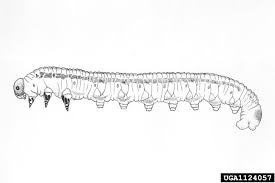
polypod larva
oligopod larva
segmented thoracic legs, “few feet” in beetle larva
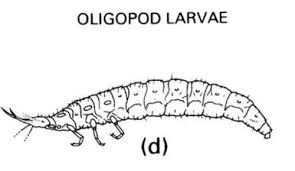
oligopod larva
apod larva
no legs, in maggots
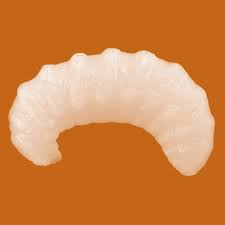
apod larva
exarate pupae
Have appendages not tightly appressed to the body
decticous exarate pupae
Have articulated mandibles used to cut open cocoon
adecticous exarate pupae
Non articulated mandibles, adult sheds pupal cuticle and used legs and mandibles to escape cocoon
obtect pupae
Enclosed in firm pupal case, cuticle is heavily sclerotized w/appendages tightly appressed to body, adecticous only
puparium
Formed under last larval exoskeleton, pupa forms under this
cocoon
Covering made to cover pupa
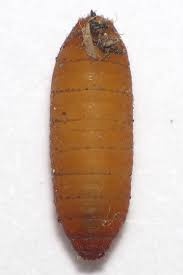
puparium
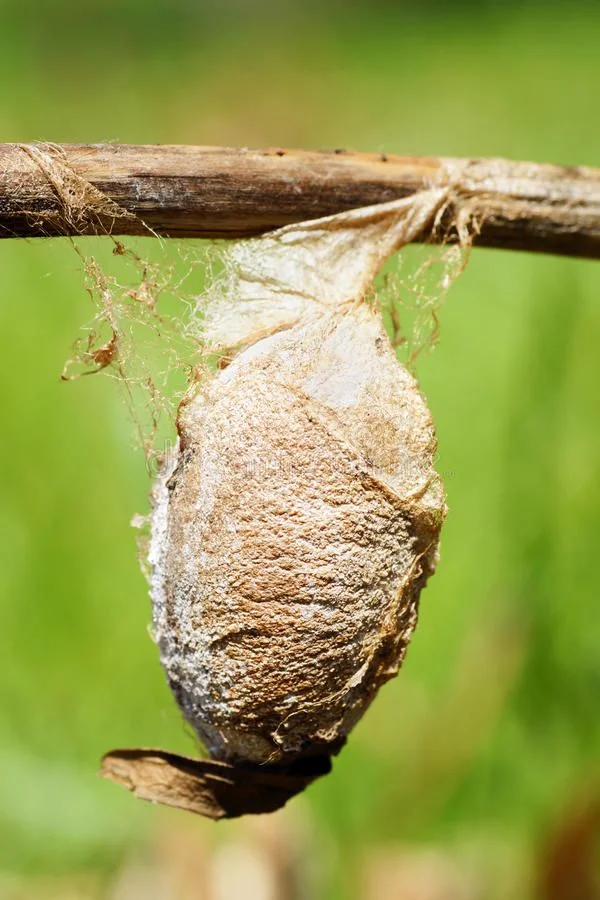
cocoon
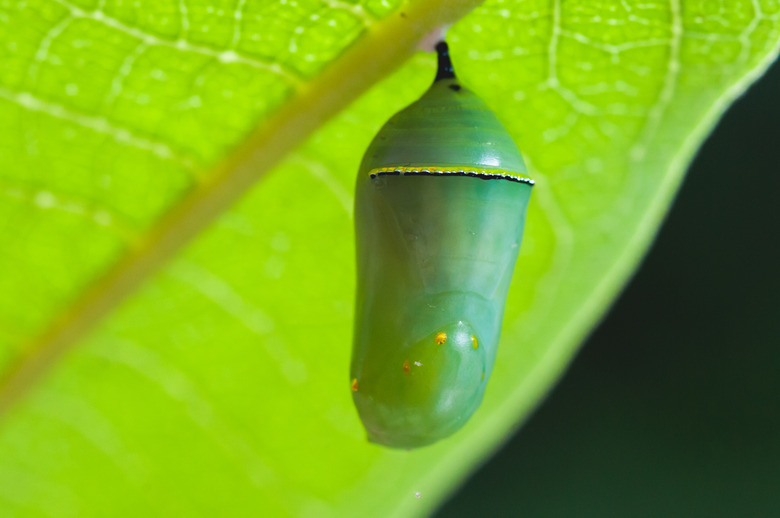
chrysalis
What factors affect development?
Life cycle duration and reproductive strategy - Number of times they reproduce and number of eggs produced involves tradeoffs and may maximize survival
voltinism
Number of generations per year, measure of how long life cycle is
univoltive life cycle
egg→adult=1 year
One generation per year, reproduces annually, most insects
biovoltine life cycle
Complete life cycle in one year but lay eggs twice
multivoltine life cycle
Produce more than two generations per year (aphids)
semivoltine life cycle
May take 2-3 years to complete life cycle (cicadas live for 7-13 years)
What factors influence insect development?
Temperature (ectothermic=unstable internal temp influences chemical rxn rate), food availability, pauses in development
aestivation
Long term dormancy in summer, may be from high temp, low water, low food resources
hibernation
long term winter dormancy
torpor
short term dormancy in summer or winter from extreme temperature
quiescence
aestivation, hibernation, or torpor in response to unfavorable conditions w/development resuming after physiological stimulus
diapause
Aestivation or hibernation with adaptive physiological change, development resumes following a stimulus
Obligatory diapause
Occurs at fixed time regardless of varies env. conditions in each generation. (ex. mosquitos lay eggs above water level to diapause until optimal conditions (water cover) reduces oxygen and temp around eggs to resume development)
facultative diapause
Occurs in bivoltine and multivoltine insects when they must survive unfavorable conditions. Pushed development from univoltine to other types.
The speckled wood butterfly is univoltine in the south and bivoltine in the north- Why isn’t it considered obligatory diapause?
It is facultative diapause because this diapause doesn’t occur in every population, only those undergoing cold temperatures in the north
reproductive diapause
A cessation or suspension of reproduction in mature insects so metabolism is redirected to other physiological needs, such as migration, producing cryoprotectants during temp extremes, food